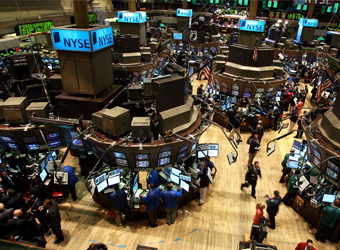U.S. equities closed flat to higher Friday, taking a breath from their most recent run at record levels, while investors awaited President Donald Trump’s speech to Congress next week.
“I’m not necessarily expecting him to say exactly what he’s going to do,” said Kim Forrest, senior equity analyst at Fort Pitt Capital. She does expect Trump to indicate that some of his key proposals, notably tax reform, deregulation and repealing Obamacare, can be put into law sometime this year.
However, experts are concerned that this timetable may not be feasible, given Congress’ agenda already includes repealing Obamacare and a Supreme Court nomination.
Trump is set to speak at a joint Congress session Tuesday night.
“One of the things you can project is that we’re going to get a roadmap on what they’re going to do,” said Art Hogan, chief market strategist at Wunderlich Securities, adding: “I think that will be helpful.”
The Dow Jones industrial average ended marginally higher, recording its 11th straight record close and its longest winning streak since 1992.
The S&P 500 rose 0.15 percent to close at a record high, with utilities rising 1 percent to lead advancers. The Nasdaq composite gained 0.17 percent, posting a five-week winning streak.
Shares of J.C. Penney fell more than 5 percent after reporting mixed quarterly results and announcing it will close up to 140 stores. Hewlett Packard Enterprise saw its stock decline more than seven percent after missing revenue estimates and slashing its full-year guidance.
Stocks held lower for most of Friday’s session, before climbing into positive territory in the last hour of trade.
“It does look like things have softened up a bit,” said Randy Frederick, vice president of trading and derivatives at Charles Schwab.
“But I don’t see any major meltdown coming. The economic backdrop is still incredibly strong,” Frederick added.
Dow futures briefly fell more than 100 points about 30 minutes before the open. The Dow and S&P 500 entered Friday’s session on track to post weekly gains, while the Nasdaq was marginally negative week to date.
European stocks also fell, with the pan-European Stoxx 600 index declining 0.76 percent.
U.S. Treasury and gold prices rose. The benchmark 10-year note yield fell to 2.33 percent, while the two-year note yield declined to 1.15 percent. Gold futures for April delivery jumped $6.90 to settle at $1,258.30 per ounce.
“Global stocks were exposed to downside shocks on Friday as the growing concerns over U.S trade policies impacting regional economies sparked waves of risk aversion,” said Lukman Otunuga, research analyst at FXTM.
“The heightened political risks in the U.S and Europe have revived an appetite for safe-haven assets with Gold becoming an investor’s popular choice,”
In the U.S., the major stock indexes have surged recently on the back of comments made by Trump that a tax reform plan could come soon.
Treasury Secretary Steve Mnuchin told CNBC on Thursday that his goal was to get something through Congress by the August recess.
Trump addressed the Conservative Political Action Conference on Friday, essentially taking a postelection victory lap.
In economic news, U.S. new home sales rose 3.7 percent in January, below the expected increase of 6.3 percent. Meanwhile, consumer sentiment in the U.S. hit 96.3 in February, slightly above an estimate of 96.
The U.S. dollar chopped around the flatline against a basket of currencies, with the euro near $1.057 and the yen around 112.1.
The greenback is down about one percent this year after staging a sharp rally after November 8, and was mostly flat for the week.
“The overall trend has been a little weaker for the last week or so. I think a lot of that has to do with the Fed minutes,” said Minh Trang, senior FX trader at Silicon Valley Bank.
The Federal Reserve released the minutes from its policymaking meeting, which took place earlier this month, on Wednesday. In them, the central bank indicated it could raise rates fairly soon.
But Trang said that currency traders were being cautious as memories from 2016 lingered. The Fed had said it could raise rates four times at the start of last year, but only tightened policy one time. “It’s a situation of ‘fool me once, shame on you. Fool me twice, shame on me.'”
The Dow Jones industrial average rose 11.44 points, or 0.05 percent, to close at 20,821.76, with Wal-Mart leading advancers and Goldman Sachs lagging.
The S&P 500 gained 3.53 points, or 0.15 percent, to end at 2,367.34, with utilities leading nine sectors higher and financials and energy the only decliners.
The Nasdaq composite advanced 9.80 points, or 0.17 percent, to close at 5,845.31.
About five stocks advanced for every four decliners at the New York Stock Exchange, with an exchange volume of 934.37 million and a composite volume of 3.806 billion at the close.
The CBOE Volatility Index (VIX), widely considered the best gauge of fear in the market, traded near 11.4.
High-frequency trading accounted for 52 percent of February’s daily trading volume of about 6.81 billion shares, according to TABB Group. During the peak levels of high-frequency trading in 2009, about 61 percent of 9.8 billion of average daily shares traded were executed by high-frequency traders.
Source: CNBC
